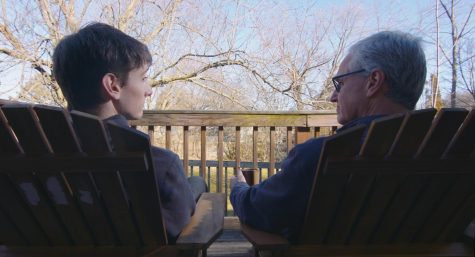New campus signs promote hospitality and navigational ease for visitors
Though student reaction has been mixed, Calvin hopes for the new signs to serve a greater visual and practical purpose. Photo by Mark Peless.
“A simple and straightforward message system will direct them to destinations, minimize confusion and make them feel welcome,” the Signage and Wayfinding Master Plan promises for future guests to Calvin College.
In July 2016, an analytics team from Ayers Saint Gross — a design firm based in Baltimore, Maryland — visited campus in order to develop the current master plan. Since the team’s portfolio had included recent designs for the College of Charleston and their Environmental Campus Wayfinding project, the Ayers Saint Gross team was quick to point out inconsistencies with various signage around Calvin’s campus, especially temporary signs used to direct traffic for different events, to a steering committee comprised of Calvin faculty and staff.
“Ayers Saint Gross brought in the comparisons to other colleges. When we were in the initial thinking stage about it, we were able to kind of see how there was a standard being set,” stated Tim Ellens, director of communications and brand steward at Calvin, who reviewed brand alignment on the steering committee.
The committee reviewed three design styles for signage, created through the responses of focus groups with students, staff and faculty. Then, the committee narrowed the decision down to the final installation of the prairie-style signs, which is currently being coordinated by Phil Beezhold, director of physical plant.
“One of the planning principles from the 2015 Campus Master Planning process was that the design of our campus would be hospitable, with ease of access and navigation,” states Sally Vander Ploeg, vice president for administration and finance, “Unfortunately, we frequently heard from visitors, including prospective students and parents, that our campus was not easy to navigate due to a lack of signage or identification on buildings. The Wayfinding project was meant to address those concerns.”
With the sign location plans plotted within the Signage and Wayfinding Master Plan, the number of new signs roughly totals 150. Similar projects at other institutions have cost between $300,000 and $525,000. Clayton University in Georgia estimated a project total of $261,780 in August 2015 for a similar wayfinding plan, with the average sign replacement costing $2,000. Another effort at Missouri State University in February 2010 estimated that new wayfinding signs would cost an average of $3,500 each.
“The funding for this project did not come from the operating budget of the college, but rather from an institutional account where donor funds had been set aside for strategic projects or initiatives,” Vander Ploeg continued. “Often larger projects like this can only be completed through off-budget funds utilizing a combination of donor gifts or the College Improvement Fund. Thankfully, due to the additional expertise of our physical plant team, we do sometimes use ‘budget dollars’ by using their expertise in installation of signs. This often decreases the overall cost of the project to the college.”
As with many new changes to campus, student opinion has been mixed.
“Why fix it when it wasn’t broken? There are many other programs that need more funding,” Megan Sebastian, a first-year student, protested. Her voice represented many like-minded students as the new signs were gradually installed.
Yet Ellens stressed the difficulties students and guests faced when first coming to campus and the new signs importance in attracting students to campus:
“When you have a couple buildings that have the word Spoelhof in them, that can get really confusing after a while if you don’t identify these things correctly. … If you provide a better experience for people who are visiting, then maybe they have a better impression about who you are as a school.”
As a first-year student at Calvin, Amy Block took a different perspective to the new signs:
“For me, the signs take away from the beauty of the buildings and nature around them.” She added, “When I came to Calvin for a visit, I would have to ask people for directions because there were a limited number of signs. Asking for directions led to insightful conversations with the people I encountered and made my Calvin visit even more pleasurable. The signs make visitors turn to them opposed to the people of this campus.”
Although Ellens acknowledged the purity of limited signage from an architectural standpoint, he argued that a compromise was necessary in order to show hospitality to external audiences coming to Calvin. Ellens posed a question to the Calvin community: “You’d have to ask yourself, do you want an environment where people have to ask where they need to go or do you want an environment where they can quickly see where they need to go?”







